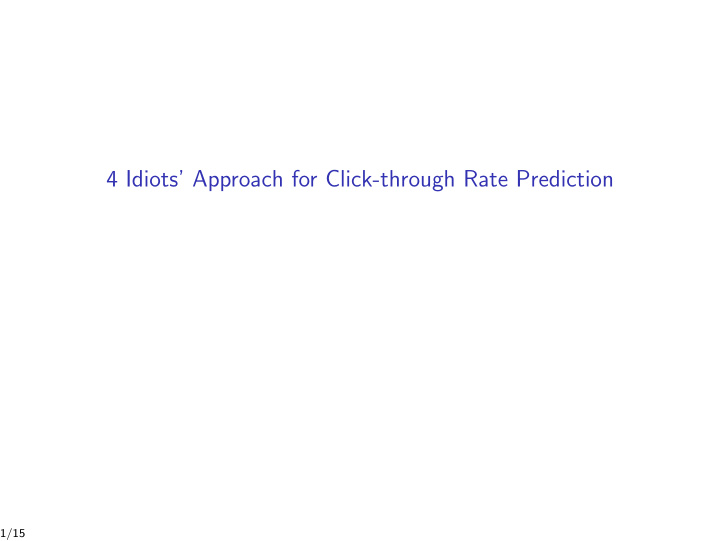



4 Idiots’ Approach for Click-through Rate Prediction 1/15
Team Members 4 Idiots consist of: Name Kaggle ID Affiliation Yu-Chin Juan guestwalk National Taiwan University Wei-Sheng Chin mandora National Taiwan University Yong Zhuang yolicat National Taiwan University Michael Jahrer Michael Jahrer Opera Solutions Our final model is an ensemble of NTU’s model and Michael’s model. Michael’s model is based on his work in Opera Solutions, so he cannot release his part. Therefore, in the released codes and documents we only present NTU’s solution. 1 1 The private leaderboard score of NTU’s solution is 0.3796, so the rank keeps unchanged. 2/15
Data Set all features are categorical � �� � Label hour banner pos site id site domain C20 . . . +1 14102100 0 1fbe01fe f3845767 -1 . . . -1 14102100 1 fe8cc448 9166c161 100084 . . . 40M . . . -1 14103023 1 f61eaaae 25d4cfcd 100077 . . . ? 14103100 0 8fda644b 7e091613 100084 . . . ? 14103100 1 e151e245 f3845767 100019 . . . 4M . . . ? 14103123 0 1fbe01fe bb1ef334 -1 . . . 3/15
Evaluation Logarithmic loss is used in this competition: L logloss = − 1 � y i log p i + (1 − y i ) log (1 − p i ) , L i =1 where L is the number of instances, y i ∈ { 0 , 1 } is the label of the i th instance, and p i is the probability of that the i th instance is clicked. 4/15
Flow Chart Our best model is an ensemble of 20 models. These models are built under the yellow part of the flow chart below with different settings. Output Data Feature Hashing Subset FFM Ensemble Engineering 20 models 5/15
Subset Instead of using the whole dataset, in this competition we find splitting data into small parts works better than directly using the entire dataset. For example, in one of our models we select instances whose s ite id is 8 5f751fd; and in another one we select instances whose a pp id is e cad2386. 6/15
Feature Engineering Except the raw features, we generate the following additional features: • Counting features • Bag features • Click history 7/15
Counting Features Counting features include: • device ip count • device id count • hourly user count • user count • hourly impression count Here, user is defined as: � device ip + device model , if device id is a99f214a otherwise device id , An impression is defined as concatenating all raw features together. 8/15
Bag Features For each user, we add bags of features. For example, if we have user1 associated with app id-A and app id-B , and user2 associated with app id-C and app id-D , then we generate an additional feature bag of app id : user app id bag of app id user1 A A, B user1 B A, B user2 C C, D user2 D C, D 9/15
Click History We generate a click history feature for users who have device id information. For example: label user history 0 user1 1 user1 0 1 user1 01 0 user1 011 10/15
Hashing We use hashing trick to transform text features. For example: mod 10 6 hash function text hash value feature site id-68fd1e64 739920192382357839297 839297 app id-80e26c9b 839193251324345167129 167129 11/15
Field-aware Factorization Machines (FFM) For details of FFM, please check the following slides: http://www.csie.ntu.edu.tw/~r01922136/slides/ffm.pdf This model is also used in another CTR competition. 2 We are interested to see if it can be more widely used. If you want to use this model, we have released a package LIBFFM at: http://www.csie.ntu.edu.tw/~r01922136/libffm 2 https://www.kaggle.com/c/criteo-display-ad-challenge 12/15
Ensemble By using different settings for subset / feature engineering / FFM, we totally built 20 models. We use a simple average approach to blend them. For example, if an impression has three predictions 0.1, 0.15, and 0.08 from three different models, then the averaged prediction is: p = f ( f − 1 (0 . 1) + f − 1 (0 . 15) + f − 1 (0 . 08) ) = 0 . 1067 , 3 where f is logistic function and f − 1 is the inverse function of f . 13/15
Source Codes The source codes of our solution can be obtained at: https://github.com/guestwalk/kaggle-avazu If you want to re-use our model, please download LIBFFM at: http://www.csie.ntu.edu.tw/~r01922136/libffm 14/15
Miscellaneous • Our solution includes many parameters (e.g. number of iteration in the FFM solver). Most of parameters are tuned by running experiments on a 10% subset of the raw dataset. • In these slides, we focus on presenting important concepts of our solution. For ease of understanding, some details are not disclosed. For example, for each counting feature, actually we only consider those smaller than a certain threshold. To understand all details, please trace our code. Of course, you can also ask questions on the forum. It’s very welcomed! • In this competition, FFM is an effective model. However, because our competitors also use FFM, 3 it is not the key to win this competition. We conclude that the keys are feature engineering and ensemble. It is worth noting that our ensemble is blending the same model (i.e., FFM) built from different subsets of data and features. 3 We are really happy to see some teams use our codes released in Criteo’s CTR competition! 15/15
Recommend
More recommend